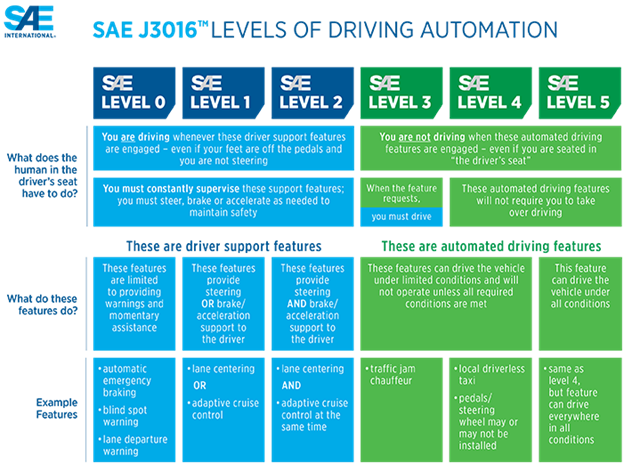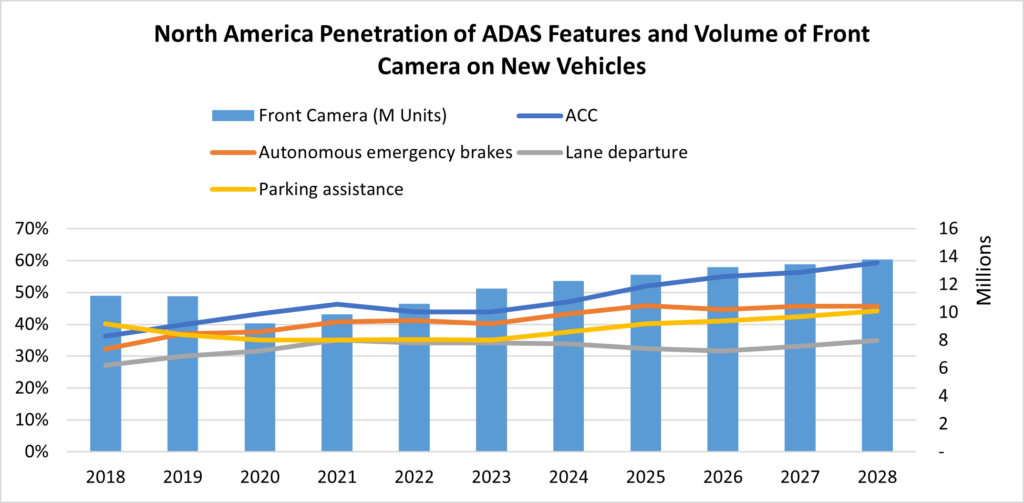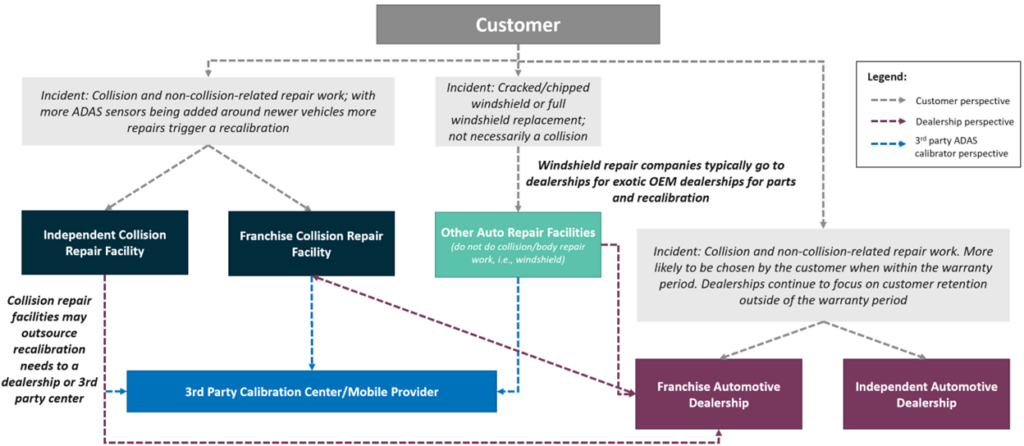Advanced Driver Assistance Systems (ADAS) improves vehicle safety and convenience by providing features such as lane keeping, adaptive cruise control, and collision avoidance. However, these features require recalibration during various maintenance events to function properly. This trend poses new challenges and opportunities for the aftermarket repair industry. This whitepaper examines how ADAS affects the current and future state of vehicle maintenance and repair, and why it is crucial to address these issues.
The adoption of ADAS features in vehicles has witnessed significant growth over the past decade. In the current state, most vehicles are equipped with Level 1 (L1) or Level 2 (L2) ADAS capabilities. The introduction of driver monitoring cameras (DMCs) in Level 2 and 3 Advanced Driver-Assistance Systems (ADAS) like Ford BlueCruise and GM SuperCruise is indeed blurring the lines between traditional driver engagement and hands-free driving.

(Source: SAE)
As ADAS features become more mainstream, vehicles will move towards Level 3 (L3) automation and higher, where recalibration is required. This increase in penetration of ADAS will lead to higher demand for recalibration in the coming years.

(Sources: Ducker Carlisle, Global Data)
Recalibration can occur during a collision or even non-collision events as long as there is sensor disruption, and as the number of sensors in newer vehicle models grow, the number of events that may require a recalibration also increases.
Events triggering the need for ADAS recalibration are on the rise, driven by various factors such as minor collisions, windshield replacements, and changes in vehicle components. The need for recalibration increases significantly with each level due to the growing complexity and interdependence of sensors and systems. Even minor repairs or replacements affecting sensor placement or alignment might necessitate recalibration. Front-end collisions, depending on severity, might trigger recalibration of multiple sensors or the entire system in higher levels. Common events requiring recalibration include:
- Minor collision
- Collision repair
- Windshield or side view mirror replacement
- Suspension repairs
- Wheel alignment
- Sensor/mounting bracket replacement
- Change in tire size
- Front airbag deployment
- Radiator and condenser repairs necessitating the removal of front-mounted sensors
When an incident occurs triggering a recalibration need, customers typically go to the dealership, especially if a vehicle is under warranty. Some customers send their vehicle to collision repair facility as well. However, in most cases, collision repair facilities are outsourcing recalibration needs to a dealership or 3rd party center without informing the customer. Primary factors driving repair shops to outsource ADAS recalibration include:
- High financial investment : Proper ADAS calibration systems are, on average, a $30k-$45k investment and require dedicated space in a service bay, as opposed to a ~$600-$1,200 cost per event to outsource; Repair shops view ADAS recalibrations as a pass-through cost, not a profit driver. Another potentially ‘hidden’ cost is to have the right equipment and software that can work with the various OEM brands. Some recalibration and diagnostic tool brands may only recalibrate certain vehicle makes and models. The unreadiness of many facilities to install recalibration equipment, including: physical space requirement, flat floors, ability to control lighting dynamically, etc., will also lead to investment in workshop upgrades
- Uncertainty regarding insurance coverage: Repair shops find insurance companies are more likely to cover ADAS recalibration when done with a dealership as opposed to in-house, especially regarding OEM “recommended” vs. “required” services. Typically repair shops perform both static and dynamic recalibration to protect themselves from liability in the event of an accident
- Protection against liability: By outsourcing, shops can gain a level of protection as dealerships and specialized ADAS Calibration Centers are believed to have the latest OEM requirements and training

The aftermarket repair landscape offers a range of solutions for ADAS recalibration, including static and dynamic recalibration methods. Each method has its pros and cons, influencing their suitability for different recalibration scenarios. Static calibration requires a diagnostic tool and manufacturer makes’ targets. The vehicle uses the targets with assistance from the scan tool to complete recalibration. This type of calibration requires a controlled environment with a dedicated building footprint (~30×45 feet) and a scanner to communicate with the modules of the vehicle. Dynamic calibration requires a diagnostic tool only and the ability to drive the vehicle a sustained speed without interruption. To complete a dynamic calibration the vehicle must be driven for a predetermined distance and speed in optimal weather conditions. The vehicle uses roadside markers and a scan tool to monitor the progress.
A few considerations and requirements are associated with both methods:
| Static | Dedicated floorspace: The space needed to recalibrate a vehicle can vary by OEM, vehicle, or calibration type; typically, a space of 30 x 45 sq. ft. is necessaryLevel floor: placement of targets or radar reflectors must be in an indoor shop environment Evenly disbursed lighting: The calibration area should be well lit with evenly distributed light. It is typically recommended to cover windows with direct sunlight to avoid inadvertently impacting the sensor Significant financial investment; systems range from $30-60k |
| Dynamic | Requires a service drive to complete; requirements of distance and speed intervals will vary In some cases, may require pre-alignment or static calibration before a dynamic calibration Difficult to complete accurately during inclement weather conditions Additionally poses a liability for shops sending technicians to drive customer vehicles outside of a controlled shop environment |
Moreover, aftermarket repair facilities have varying options for ADAS recalibration, from portable devices for windshield recalibration to comprehensive online platforms that provide technician support.
Dealerships and repair facilities work with calibration suppliers in different ways, options including purchase, lease, and Equipment as a Service (EaaS) model. Each business model has its own set of pro’s and con’s that are unique to each end-user profile.
Several suppliers, including asTech, Autel, Bosch, BPG, Hunter, and Snap-On, offer products and business models ranging from simple hand-held scanning devices to full turn-key systems. These systems can ensure accurate wheel alignment, diagnose and recalibrate the full sensor suite, and save specifications for future reference.
Despite advancements in aftermarket repair solutions, several challenges persist in the ADAS recalibration landscape such as technician shortage, equipment compatibility, and certification. The shortage of skilled technicians at repair shops creates a bottleneck, leading to increased repair times for recalibration events. Compatibility issues between OEM systems and aftermarket equipment often force consumers to rely on dealerships for recalibration, limiting their options and potentially increasing costs. Ensuring the precision and effectiveness of recalibration work is crucial for ADAS features to function correctly. Proper certification standards are needed to guarantee the safety and reliability of recalibration procedures.
Addressing the challenges in the ADAS aftermarket recalibration landscape is paramount. The ADAS aftermarket recalibration market is projected to reach $5-6 billion by 2028. Independent and franchise repair or recalibration facilities play a crucial role in serving this growing market segment, necessitating access to certified equipment and trained technicians. In addition, proper recalibration is essential for ensuring the effective functioning of ADAS features, thereby enhancing overall vehicle safety and reducing the risk of accidents. Despite some state level regulations, current federal regulations lack oversight and/or clear repair requirements for vehicles requiring ADAS recalibration. Nevertheless, Ducker Carlisle anticipates that liability concerns due to the increasing number of vehicles equipped with ADAS will force insurance agencies to implement specific recalibration tracking by repair facility for traceability/liability.
In conclusion, the evolving landscape of ADAS in vehicles necessitates a proactive approach to aftermarket recalibration, addressing challenges, and leveraging opportunities to meet the growing demand for reliable and efficient repair solutions. By investing in technology, training, and certification standards, the automotive industry can ensure the continued advancement and adoption of ADAS features while prioritizing driver safety and satisfaction.
Ducker Carlisle’s decades of automotive consulting experience and comprehensive expertise in auto and light truck manufacturing, electrification, aftersales, and parts benchmarking help automotive clients secure an advantage in a shifting global market. Learn more here.
Article Prepared By:
Leonard Ling, Senior Analyst – Automotive Knowledge Manager
Matthew Trentacosta, Engagement Manager